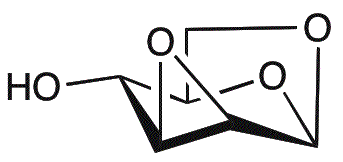1,6:2,3-Dianhydro-b-D-mannopyranose is widely utilized in research focused on:
- Pharmaceutical Development: This compound serves as a key intermediate in the synthesis of various pharmaceutical agents, enhancing drug efficacy and bioavailability.
- Food Industry: It is used as a sugar substitute in low-calorie and diabetic-friendly products, providing sweetness without the calories of traditional sugars.
- Biotechnology: In the production of glycoproteins, it acts as a stabilizing agent, improving the yield and stability of biopharmaceuticals.
- Cosmetics: Its moisturizing properties make it a valuable ingredient in skincare formulations, helping to retain skin hydration and improve texture.
- Research Applications: It is employed in carbohydrate chemistry studies, aiding researchers in understanding sugar metabolism and developing new carbohydrate-based materials.
General Information
Properties
Safety and Regulations
Applications
1,6:2,3-Dianhydro-b-D-mannopyranose is widely utilized in research focused on:
- Pharmaceutical Development: This compound serves as a key intermediate in the synthesis of various pharmaceutical agents, enhancing drug efficacy and bioavailability.
- Food Industry: It is used as a sugar substitute in low-calorie and diabetic-friendly products, providing sweetness without the calories of traditional sugars.
- Biotechnology: In the production of glycoproteins, it acts as a stabilizing agent, improving the yield and stability of biopharmaceuticals.
- Cosmetics: Its moisturizing properties make it a valuable ingredient in skincare formulations, helping to retain skin hydration and improve texture.
- Research Applications: It is employed in carbohydrate chemistry studies, aiding researchers in understanding sugar metabolism and developing new carbohydrate-based materials.
Documents
Safety Data Sheets (SDS)
The SDS provides comprehensive safety information on handling, storage, and disposal of the product.
Product Specification (PS)
The PS provides a comprehensive breakdown of the product’s properties, including chemical composition, physical state, purity, and storage requirements. It also details acceptable quality ranges and the product's intended applications.
Certificates of Analysis (COA)
Search for Certificates of Analysis (COA) by entering the products Lot Number. Lot and Batch Numbers can be found on a product’s label following the words ‘Lot’ or ‘Batch’.
Número de catálogo
Número de lote/lote
Certificates Of Origin (COO)
This COO confirms the country where the product was manufactured, and also details the materials and components used in it and whether it is derived from natural, synthetic, or other specific sources. This certificate may be required for customs, trade, and regulatory compliance.
Número de catálogo
Número de lote/lote
Safety Data Sheets (SDS)
The SDS provides comprehensive safety information on handling, storage, and disposal of the product.
DownloadProduct Specification (PS)
The PS provides a comprehensive breakdown of the product’s properties, including chemical composition, physical state, purity, and storage requirements. It also details acceptable quality ranges and the product's intended applications.
DownloadCertificates of Analysis (COA)
Search for Certificates of Analysis (COA) by entering the products Lot Number. Lot and Batch Numbers can be found on a product’s label following the words ‘Lot’ or ‘Batch’.
Número de catálogo
Número de lote/lote
Certificates Of Origin (COO)
This COO confirms the country where the product was manufactured, and also details the materials and components used in it and whether it is derived from natural, synthetic, or other specific sources. This certificate may be required for customs, trade, and regulatory compliance.


